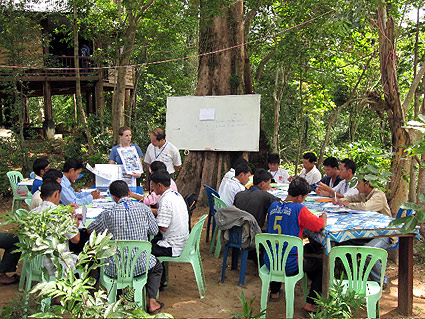
Fish live in water where they are difficult to see, catch, and assess their health and abundance. That typically means research projects are labor intensive and expensive. As is evident in this picture, many people can be involved in fisheries field research. In this case, FISHBIO trained local villagers in Lao PDR to collect fish abundance and harvest data, which serves several purposes. First, hiring local staff at local prevailing wages keeps the overall cost of the research project reasonable. Second, and more importantly, this research provides jobs to local people in a region where finding work can be difficult. Perhaps most importantly, projects such as this one increases local residents’ understanding of their fishery resources and hopefully leads to better conservation efforts.
This outdoor classroom provided a nice setting for a week-long crash course in species identification. In this region of the Mekong River, it is believed there are around 100 fish species, of which only about 60 have been described in scientific literature. In addition to providing opportunities to discover new species, it also poses challenges with data collection and scientific accuracy. Upon graduating from their week-long classroom training, these new fish technicians began another week of intensive field training, after which they completed an 18-month-long effort to assess their local fishery and harvest practices.